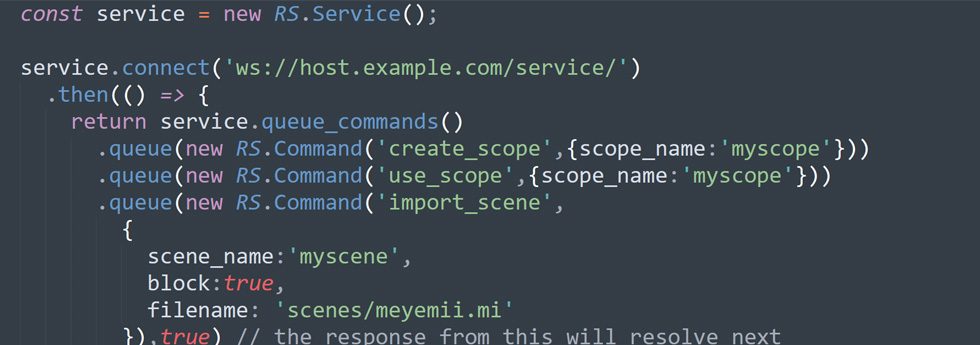
The legacy JavaScript client library shipped with RealityServer was designed in 2010, back when JavaScript in the browser was mostly unusable without some sort of framework like jQuery, WebSockets were still under design and JavaScript on the server was virtually unheard of. A lot has changed since then, JavaScript has significantly evolved and is supported by a huge module ecosystem, WebSockets are under the hood of everything and Node.js is becoming ubiquitous. The RealityServer client library however has barely changed. Until now.
Paul Arden has worked in the Computer Graphics industry for over 20 years, co-founding the architectural visualisation practice Luminova out of university before moving to mental images and NVIDIA to manage the Cloud-based rendering solution, RealityServer, now managed by migenius where Paul serves as CEO.

RealityServer 5.1 introduced new functionality for working with canvases in V8. In this post I’m going to show you how to do some basic things like resizing and accessing individual canvas pixels. We’ll build a fun little command to render a scene and process the result into a piece of interactive ASCII art. Of course, this doesn’t have much practical utility but it’s a great way to learn about this new feature!
Paul Arden has worked in the Computer Graphics industry for over 20 years, co-founding the architectural visualisation practice Luminova out of university before moving to mental images and NVIDIA to manage the Cloud-based rendering solution, RealityServer, now managed by migenius where Paul serves as CEO.

In this, the second part of our article on transformations I will introduce SRT (Scaling, Rotation, Translation) transformations. Unlike the previous article, this one will have a lot less maths and shows you a simpler way to work with transformations in RealityServer. Additionally the method allows for automatic interpolation of transformations over time in a smooth way which is great for creating animations. Once things are moving you can also introduce motion blur for more realistic results. Read on to discover the ease of SRT transformations.
Paul Arden has worked in the Computer Graphics industry for over 20 years, co-founding the architectural visualisation practice Luminova out of university before moving to mental images and NVIDIA to manage the Cloud-based rendering solution, RealityServer, now managed by migenius where Paul serves as CEO.

Transformations are fundamental to working with 3D scenes and something that can be frequently confusing to those that haven’t worked in 3D before. In this, the first of two articles I will show you how to encode 3D transformations as a single 4×4 matrix which you can then pass into the appropriate RealityServer command to position, orient and scale objects in your scene. In a second part I will dive into a newer method of specifying transformations in RealityServer called SRT transformations which also allows for the easy animation of objects.
Paul Arden has worked in the Computer Graphics industry for over 20 years, co-founding the architectural visualisation practice Luminova out of university before moving to mental images and NVIDIA to manage the Cloud-based rendering solution, RealityServer, now managed by migenius where Paul serves as CEO.

In this article I am going to show you how add light sources to your RealityServer scene using the Web-services API. You will learn how to add several different types of lights, including a photometric light using an IES data file, an area light, a spot light and daylight. This will be a very simple example but will give you all of the pieces you need to programmatically add lighting to your scene. You can expand on the concepts shown here to make different types of lighting very easily.
Paul Arden has worked in the Computer Graphics industry for over 20 years, co-founding the architectural visualisation practice Luminova out of university before moving to mental images and NVIDIA to manage the Cloud-based rendering solution, RealityServer, now managed by migenius where Paul serves as CEO.

In this article I am going to show you how to create a simple 3D scene, completely from scratch using RealityServer. You will learn about the anatomy of a RealityServer scene and the different components that go into making it up, including options, groups, instances, cameras, geometry and environment lighting. While the scene will be very simple there will be many key principles of RealityServer and NVIDIA Iray demonstrated which you can expand on to build more complex scenes.
Paul Arden has worked in the Computer Graphics industry for over 20 years, co-founding the architectural visualisation practice Luminova out of university before moving to mental images and NVIDIA to manage the Cloud-based rendering solution, RealityServer, now managed by migenius where Paul serves as CEO.

When getting started with RealityServer, many customers ask us the best place to begin in order to learn how RealityServer works. One of the best and most enjoyable ways we find is to explore the JSON-RPC API which remains the main way that RealityServer functionality is accessed. In this article we will provide an overview of how the RealityServer JSON-RPC API works and some of the best ways to explore and play with functionality exposed there. Whether you are new to RealityServer or a veteran user you will find some valuable pointers.
Paul Arden has worked in the Computer Graphics industry for over 20 years, co-founding the architectural visualisation practice Luminova out of university before moving to mental images and NVIDIA to manage the Cloud-based rendering solution, RealityServer, now managed by migenius where Paul serves as CEO.